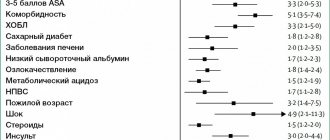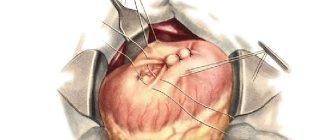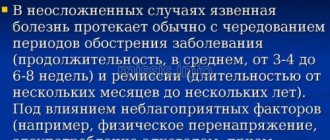Peptic ulcer disease: familiar and so many-sided
Peptic ulcer
– a chronic, cyclically relapsing polyetiological disease, the main morphological substrate of which is an ulcerative defect and/or a scar within the gastroduodenal zone, manifested mainly by abdominal pain syndrome and gastric dyspepsia syndrome.
Exacerbation of the disease: when the ulcer is localized in the cardial and subcardial parts of the stomach - early pain, with ulcers of the antrum, pyloric canal and duodenum - late pain, as well as “hungry” and “night” pain. Appetite usually does not decrease, and often even increases, especially with duodenal localization of the ulcer (“painful feeling of hunger”). The general condition of patients worsens, increased fatigue, weakness, sweating, loss of ability to work appear, depression or, on the contrary, agitation is observed. Pain syndrome can be typical (pain is characterized by rhythm and frequency of occurrence, often appearing at a strictly defined time for a given patient - an alarm clock symptom) and atypical. Pain in the epigastric region is the most characteristic clinical symptom of peptic ulcer disease. Early – pain that appears in the first 1 – 1.5 hours after eating. Late – pain that appears 2 to 5 hours after eating. Hungry - pain that, occurring several hours after eating, quietly disappears or weakens after a new meal. Nocturnal – pain that occurs at night and causes the patient to wake up. Early pain often suggests concomitant esophagitis. There is some peculiarity of the pain syndrome. Pain of a constant nature - the involvement of the pancreas. The paroxysmal nature of the pain is due to the involvement of the gallbladder. Combination with symptoms of gastric dyspepsia (nausea, vomiting) - there is a noticeable violation of gastric evacuation of functional or organic origin.
The following types of pain syndrome in peptic ulcer disease can be distinguished:
Visceral
- pain is dull, pressing, aching, relieved by eating, antacids, pronounced periodicity, of uncertain localization in the epigastrium, does not radiate, symptoms of peritoneal irritation, local muscle tension on superficial palpation, tension of the anterior abdominal wall and skin hyperesthesia are absent, but there is local soreness in the location of the affected organ with deep palpation, which does not coincide with the subjective localization of pain;
Visceral pain syndrome with irradiation
- the pain is dull, diffuse, at the height of the pain it is acute, relieved by eating food, antacids, pronounced periodicity, irradiation is characteristic, Mendel's symptom is positive, most often only when the ulcer is localized on the anterior wall, there is local muscle tension on superficial palpation, there is no tension in the anterior abdominal wall, skin hyperesthesia in the Zakharyin-Ged zones, local pain in the area of the affected organ with deep palpation, which usually coincides with the subjective localization of pain;
Visceral-somatic pain syndrome
- the pain is acute, not relieved by food intake, antacids, there is no periodicity, characterized by pronounced irradiation, point pain in the area of the affected organ, Mendel's symptom is positive, there is local muscle tension on superficial palpation, there is no tension in the anterior abdominal wall, skin hyperesthesia at the site of the ulcer and local pain at the site of the affected organ with deep palpation, which coincides with the subjective localization of pain;
Somatic pain syndrome
with perforation into the free abdominal cavity - sharp pain, “dagger-like”, diffuse, no periodicity, irradiation, point pain in the area of the affected organ, positive Mendelian, Shchetkin-Blumberg symptoms, diffuse pain in the anterior abdominal wall, the anterior abdominal wall is tense, there is diffuse skin hyperesthesia at the site of the ulcer and local pain at the site of the affected organ with deep palpation, which coincides with the subjective localization of pain.
Atypical pain syndrome in peptic ulcer disease: cholecyst-like
pain syndrome
- right hypochondrium localization of pain, more often characteristic of women, with one or another involvement of the gallbladder; retrosternal pain, as with angina pectoris, aggravated by physical activity (with “high” ulcers and in the presence of perivisceritis with the formation of adhesions), however, unlike true angina, they are provoked or reduced after eating; pain in the heart area (if the ulcer is localized along the greater curvature of the stomach), appearing 30-40 minutes after eating and relieved by eating, antacids, etc. Cramping pain, reminiscent of attacks of hepatic or renal colic, occurring acutely and periodically recurring regardless of food intake and its nature. Pain localized in the umbilical region and slightly below it, reminiscent of intestinal colic, appendicitis and other diseases of the abdominal organs, often causing diagnostic errors, including appendectomy. Ossalgic variant – irradiation of pain in the back (left or right scapula, interscapular space, thoracic spine).
Gastric dyspepsia syndrome:
heartburn, belching (food, sour, air), changes in appetite (fear of eating with stomach ulcers due to provoking pain, frequent eating with duodenal ulcers to relieve pain), nausea and vomiting (hypertonicity n.vagus: hypersecretion, dysmotility and spasm of smooth muscles, including the pylorus), inflammatory swelling of the mucous membrane or cicatricial deformation of the pylorus and duodenal bulb, nausea precedes vomiting, sour vomiting, brings relief, a feeling of heaviness, fullness in the epigastrium (equivalent to pain syndrome, with motor evacuation violations).
Intestinal dyspepsia syndrome.
Constipation (more typical for duodenal ulcers): vagotonia (peristalsis, sphincter tone), dietary restrictions (fiber), taking medications (aluminum, bismuth). Diarrhea (more typical for stomach ulcers): against the background of hypochlorhydria, impaired bile secretion, impaired functioning of the pancreas, the influence of eradication therapy.
Astheno-vegetative syndrome:
general weakness, increased fatigue, emotional lability. It is necessary to exclude complications: bleeding, anemia, electrolyte disturbances with frequent vomiting, malignancy.
Clinical variants of peptic ulcer
Subcardial ulcers:
age – 40-60 years, mild and atypical pain syndrome, burning, pressure under the xiphoid process, irradiation behind the sternum, to the heart area, early pain (including during eating), insufficiency of the cardiac sphincter. Difficulties in diagnosis, cardiac masks, left-sided pleurisy. High incidence of complications.
Ulcers of the body of the stomach:
Middle age, polymorphic clinical picture, moderate pain syndrome, early pain, to the left of the midline, nausea, belching, less often - heartburn, vomiting. Complications: bleeding 15%, often massive, perforation – 4%, malignancy – 8-10%, pay attention to ulcers along the greater curvature of the stomach!
Antral ulcers:
young and middle age, clinically similar to duodenal ulcer, late pain, heartburn, belching, vomiting, bleeding 10-15%.
Pyloric canal ulcers:
Intense pain syndrome, late pain, paroxysmal, radiating to the back, persistent nausea and vomiting, feeling of fullness, rapid satiety, difficulties in X-ray diagnostics, malignancy 3-8%.
Ulcers of the duodenal bulb:
young and middle age, hereditary history, hypersecretion of HCl, pain syndrome, late and night pain, heartburn, vomiting of acidic contents, brings relief, cyclical and seasonal course, interest of the pancreas when localized on the medial wall.
Postbulbar ulcers:
persistent, long-term course, frequent recurrence, prolonged exacerbations, often multiple, hypersecretion of HCl, persistent pain syndrome, late (after 3-4 hours) and night pain, does not stop immediately, localized in the navel area, heartburn, frequent bleeding, lesions of the papilla of Vater , it is necessary to exclude symptomatic ulcers, including gastrinoma.
In adolescence:
duodenal localization, beginning with dyspeptic syndrome, vomiting, reflex nausea, weight loss, pale skin, autonomic imbalance (red dermographism, sweating, hypotension, bradycardia, constipation, low-grade fever), hypovitaminosis, often in the form of “mono-pathology” ", rare involvement of neighboring organs in the pathological process, often due to functional changes, often starting with complications.
In old age:
often - low-symptomatic and atypical course, against the background of concomitant pathology (vascular bed: hypertension, diabetes, coronary artery disease, respiratory system - hypoxia), taking ulcerogenic medications, multiple organ lesions of the gastrointestinal tract, the role of trophic factor, high localization, large size, long-term scarring, frequent complications.
Rare causes of peptic ulcer
Stomach ulcers:
adenocarcinoma, carcinoid, penetration of tumors of other organs, sarcoma, leiomyoma, foreign bodies, endocrine diseases, Crohn's disease, syphilis, tuberculosis, HIV.
Duodenal ulcers:
Zollinger-Ellison syndrome, chronic obstructive pulmonary diseases, portal hypertension, Crohn's disease, celiac enteropathy, lymphoma, lesions, CNS injuries - Cushing's ulcers, hypercalcemia, systemic mastoidosis, amyloidosis, polycythemia, HIV.
The goal of treating peptic ulcers is:
accelerate the scarring of the ulcerative defect, quickly stop the clinical manifestations of the disease (pain, dyspeptic syndromes, etc.), prevent complications and relapse of the ulcer.
Stomach ulcer: causes, symptoms, ulcer diet
26.04.2021
The stomach is covered with a thick layer of mucous membrane, which protects it from the stomach acid that is produced to digest the food eaten. However, if it is damaged, the harsh acid can cause wounds. This is stomach ulcer , causing many unpleasant ailments. What are the symptoms and causes stomach ulcers ? What should a properly formulated diet to treat an ulcer ?
Symptoms of a stomach ulcer
Pain and indigestion are the most common symptoms stomach ulcers . Stomach ulcers usually appear in the middle of the abdomen , affecting the area between the navel and the sternum. Eating food may temporarily relieve symptoms. Medicines that neutralize the effects of hydrochloric acid also help reduce discomfort. What else can happen with a peptic ulcer ?
Symptoms of a stomach ulcer:
- heartburn;
- indigestion ; _
- flatulence;
- nausea;
- feeling full after eating;
- vomit;
- lack of appetite;
- weight loss.
Causes of stomach ulcers and the bacterium Helicobacter Pylori
Helicobacter pylori infection is a common illness that should not cause any symptoms for many people. Peptic ulcer bacteria damage the lining of the stomach , thereby compromising its defenses against stomach acid, and can lead to the formation of stomach ulcers . These are not the only complications associated with Helicobacter Pylori. Peptic ulcer bacteria stomach lining and increase the risk stomach cancer . In addition to Helicobacter Pylori infection, the causes of stomach ulcers can also be associated with medications from the group of nonsteroidal anti-inflammatory drugs, NSAIDs, in particular the popular over-the-counter medications ibuprofen or aspirin. Other causes of stomach ulcers include: Zollinge-Ellison syndrome, stress and stimulants, particularly heavy cigarette smoking.
Ulcer diet
When fighting stomach ulcers , you should pay attention to dietary ingredients rich in antioxidants and probiotic foods. The diet for ulcers should be rich in vegetables and fruits, such as peppers, cauliflower, spinach, cabbage, radishes, blueberries, apples, strawberries, raspberries, cherries, as well as natural yoghurts and kefir. diet alone will not cure stomach ulcers , but it may relieve symptoms. Among the spices, it will be useful to use turmeric, which has anti-inflammatory properties, marjoram or flaxseed. It is important not only what to eat, but also what not to eat if you have stomach ulcer . The diet for peptic ulcers should not include highly processed foods containing harmful trans fats and sugar. Avoid fried and spicy foods and alcohol.
Treatment of stomach ulcers
An untreated stomach ulcer can lead to serious consequences, such as bleeding or perforation - a breach of the wall of the stomach or duodenum, so appropriate treatment is necessary. To this end, treatment for stomach ulcers is aimed at eliminating their cause, which in most cases means fighting the Helicobacter Pylori infection. The patient is given so-called proton pump inhibitors, the purpose of which is to minimize the secretion of hydrochloric acid by the proton pump in combination with antibiotics that eliminate the bacterial infection. stomach ulcer medications may help treat stomach ulcers . These include, first of all, lotions and other pharmaceuticals that neutralize the effect of stomach acids.
In the case of stomach ulcers , as with any other disease, it is much better to focus on prevention rather than treatment. So take care of your digestive system: eat often and regularly, avoid constipation, quit smoking and use NSAIDs wisely. If you notice the first symptoms stomach ulcer , do not try to cope with them on your own, but consult a doctor to begin appropriate treatment.
Published in Gastroentorology Premium Clinic







